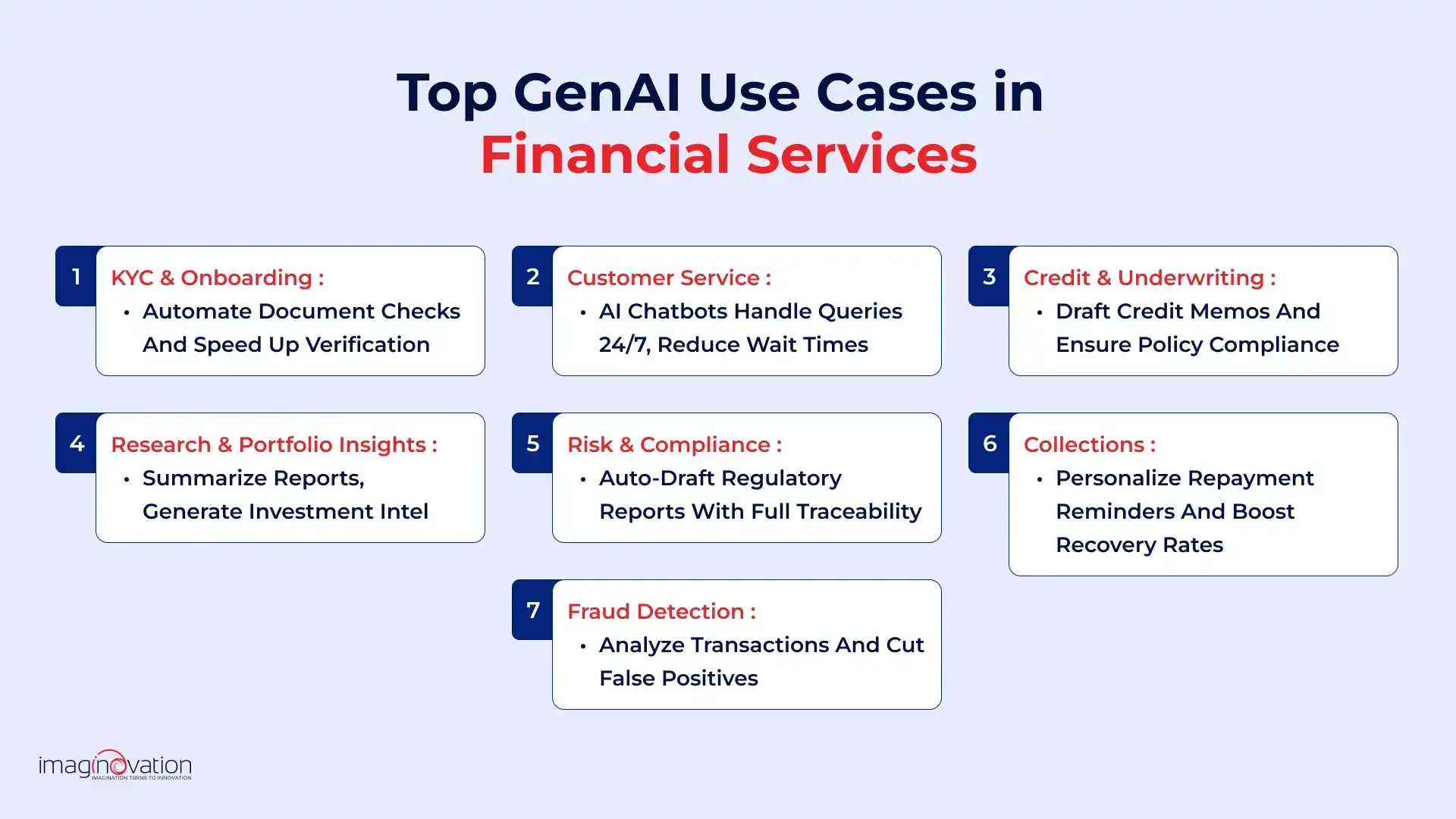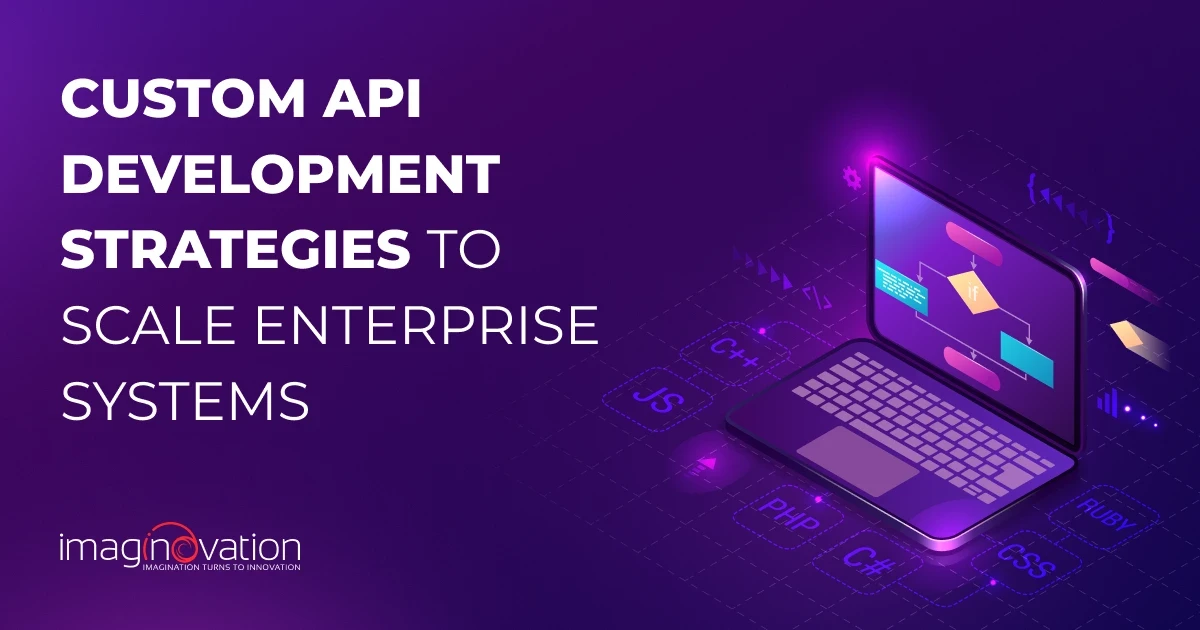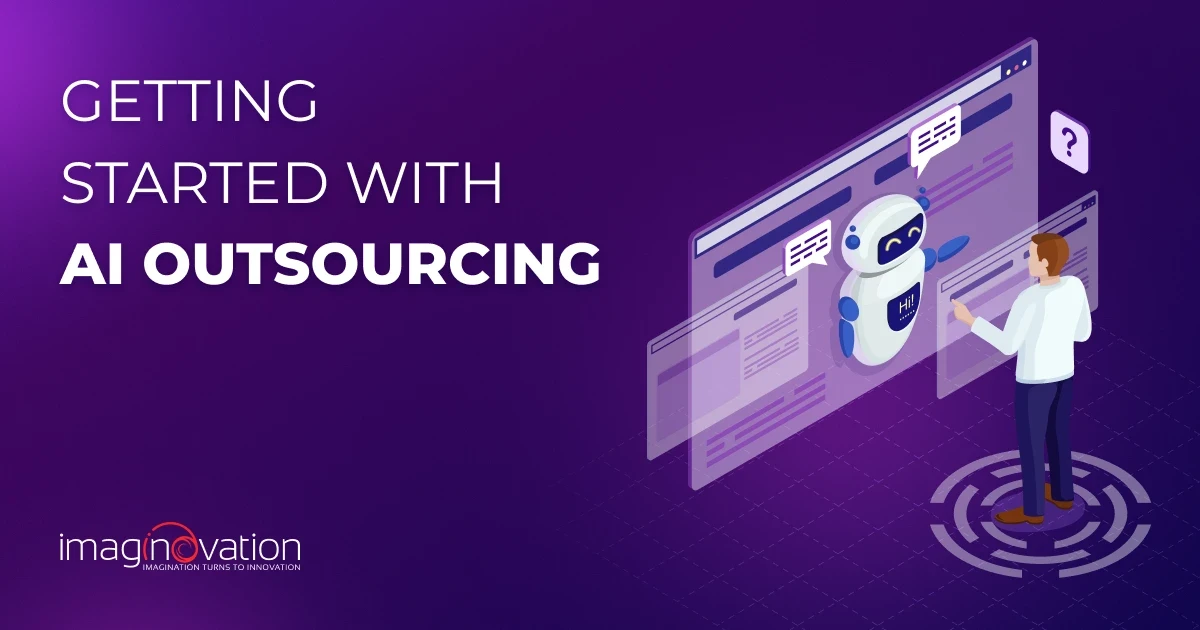Generative AI has quietly slipped into the heart of financial services.
A year ago, most banks and fintechs were still experimenting with AI. Now, they’re asking tougher questions: where does this actually add value, how do we use it safely, and how do we make it worth the effort?
According to a recent MarketsandData study, the global generative AI market in the financial services sector is projected to reach approximately USD 12.63 billion by 2032.
The eye-catching numbers underscore the importance of getting gen AI right to unlock its tremendous value.
Tag along to explore this guide, where we will offer a crisp market snapshot. Explore high-ROI use cases, benefits tied to metrics, a step-by-step start plan, and risk controls relevant to regulated Financial Services.
Let's dive in.
Generative AI in Financial Services: The Market Outlook
It's essential to keep track of what's happening in the industry, and here's a peek:
- Investment and Adoption: Generative AI attracted around $33.9B in global private investment (2024), and overall AI adoption in businesses surged to 78%, up from 55% in 2023. (Stanford HAI)
- Banking Value Potential: McKinsey projects an annual impact of $200–$340B in banking if generative AI use cases are fully scaled. (McKinsey & Company)
- Executive Usage: Over 53% of C-level leaders reported using generative AI at work in 2024, proving it’s now mainstream. (McKinsey & Company)
- Proof at Scale: Bank of America’s Erica has crossed 3B client interactions (2025), showing real-world adoption at scale. (Bank of America / CIO Dive)
- Regulatory Runway: The EU AI Act took effect on August 1, 2024, and GPAI obligations start on August 2, 2025. In this context, full enforcement is expected by 2026, which is a key milestone for financial services in regulated markets. (Digital Strategy)
What are the Best Use Cases of GenAI in Financial Services

As business leaders and entrepreneurs, it is great to study and prioritize use cases that come with precise measurement and compliance pathways.
Here are some of the best use cases of GenAI in Financial services:
1. KYC / Onboarding and Document Automation
GenAI can speed the Know Your Customer (KYC) and onboarding processes. The technology helps summarize and extract data from customer documents, including IDs, bank statements, and tax returns.
It is very handy with technology, as it can automatically extract key data, check for missing information, and generate compliance checklists for analysts.
A notable example is HSBC, which uses AI tools to validate documents and onboard customers more efficiently, reducing manual review time by almost 40%.
Proof that it's delivering: turnaround time and analyst hours saved.
2. Customer Service (Retail / Commercial Banking)
Traditionally, call center agents resolve routine customer queries, and the nature of this task adds a lot of pressure.
With AI-powered chatbots and voice assistants, tasks like checking balances, explaining fees, or resolving disputes can not only be delegated but handled efficiently and nearly 24/7.
This improves response speed and eases call center pressure.
Example: Bank of America’s virtual assistant “Erica,” which has managed over 1.5 billion customer interactions, significantly cutting average wait times.
Proof that it's delivering: Average Handle Time (AHT), Customer Satisfaction (CSAT), Containment Rate (queries solved without human help).
3. Credit and Underwriting Operations
Credit analysis, including drafting credit memos, extracting covenant details, and confirming compliance with lending policy, consumes significant time. GenAI efficiently manages these components.
Example: Banks like ING and Goldman Sachs are experimenting with AI copilots to help underwriters create detailed credit assessments more efficiently.
Proof that it's delivering: There's a tangible difference in memo turnaround time and policy compliance rate.
4. Research, Earnings, and Portfolio Intelligence
AI reads extensive earnings call transcripts, news articles, and research reports to distill insights, assess sentiment, and generate investment rationales, citing sources.
Example: Morgan Stanley’s AI “Knowledge Assistant” helps financial advisors quickly extract and summarize insights from market research reports.
Proof that it's delivering: A visible difference is found in analyst preparation time, insight accuracy, and client query response time.
Also Read: Integrating Generative AI to Create New Revenue Streams
5. Risk and Compliance Reporting
The regulatory and risk documents are complex, especially when it comes to drafting documents, including ICAAP (Internal Capital Adequacy Assessment Process) and ILAA (Individual Liquidity Adequacy Assessment).
Now, with GenAI, drafting such complex documents is easy and is based on gathering data, linking evidence, and maintaining version control.
Example: UBS uses AI internally to generate first drafts of regulatory reports, saving several hours per report.
Proof that it's delivering: There's a visible difference in report turnaround time and support in documentation completeness.
6. Collections and Servicing
GenAI personalizes communication with customers in arrears, generates empathetic repayment reminders, and suggests next-best actions or payment plans, all based on customer sentiment and history.
Example: Capital One uses AI pilots to recommend repayment messages with the right tone, improving customer engagement.
Proof that it's delivering: A notable difference in promise-to-pay rate, Net Promoter Score (NPS), and agent efficiency.
7. Financial Crime and Fraud Operations
Compliance teams spend a lot of time reviewing alerts, summarizing transaction histories, or drafting Suspicious Activity Reports (SARs). GenAI can support these tasks, reducing manual work and helping analysts focus on real threats.
Example: JPMorgan Chase uses GenAI to help investigators analyze transactions and detect anomalies faster.
Proof that it's delivering: Notable difference in case cycle time, false positive reduction, and alert-to-case ratio.
🖋️ Imaginovation Co-founder Pete Peranzo emphasized some of the most compelling real-world use cases for generative AI across banking and financial services.
Pete noted that GenAI is automating document creation and summarization, taking on tasks that were previously time-consuming, such as policy creation and review.
He further included that in customer service analytics, AI applications now process conversations and audio interactions to measure agent behavior, improve customer experience, and signal early problem areas.
Pete added that, in the context of risk assessment and compliance, AI can automatically test and conduct internal audits, ensuring institutions remain compliant with changing regulations.
GenAI can also revolutionize portfolio management and investment decisions by replicating the thought processes of top investors, enabling retail clients to make fact-based decisions.
Next, in the context of market forecasting and trading, Pete shares how AI-powered bots are being developed that may outperform benchmarks like the S&P 500, suggesting opportunities and potential disruption.
When it comes to ROI analysis and customer insights, the technology can be enhanced by quick AI-powered assessments of performance metrics, lifetime value, and sales, which enable quicker, sharper strategic decisions.
He further added that, by freeing up human talent for higher-level, strategic, and creative work, repetitive tasks such as report building and data analytics are being automated.
Bottom line: With the myriad use cases, one can clearly see how generative AI is transforming efficiency, decision-making, and the customer experience throughout the financial services industry.
Benefits of GenAI in Financial Services
Before one considers adopting any technology, a good question to ask is, "What are the benefits" (aka "what's in it for my organization or business unit).
Here are some benefits that can help to understand the scope and range of GenAI in financial services.
1. Operational Efficiency
Analysts and relationship managers often handle time-intensive tasks such as drafting, research, and documentation. One way to resolve this is to adopt GenAI that automates all such tasks, freeing executives to focus on higher-value work.
Outcome: One can clearly see costs and turnaround time decreasing.
Industry evidence: Deloitte has experienced measurable efficiency gains with GenAI applications scaling across banking operations.
2. Faster Decisions and Better Customer Experience
One can experience tremendous speed in receiving insights and responses in just a few seconds with AI tools. The phenomenal speed of delivery also enables 24/7 support and seamless digital interactions.
Outcome: There are visible differences with shorter decision cycles and higher customer engagement.
Example: Bank of America’s “Erica” shows sustained adoption, handling over 1.5 billion interactions, demonstrating consistent digital engagement.
3. Revenue Growth
Yet another exciting aspect of GenAI is the ability to personalize insights when offering next-best actions. The insights help to enhance further cross-sell and upsell opportunities across customer segments.
Outcome: A tangible boost in revenue per customer and improved product penetration.
Benchmark: McKinsey & Company’s analysis shows GenAI can unlock substantial bank-wide value when applied at scale.
4. Risk and Compliance Quality
GenAI assists in producing regulatory drafts with citations and audit trails, reducing manual errors and ensuring traceability.
Outcome: Stronger compliance accuracy and improved audit readiness.
Context: The Financial Stability Board emphasizes explainability and oversight, both of which GenAI systems can enhance.
🖋️ Pete shared a specific example of how generative AI improved efficiency in financial services: the automation of PDF creation by a FinTech company, which previously required a team of engineers and staff to produce PDFs regularly.
The implementation of an AI agent automated this process, saving significant time and resources, and effectively replacing manual effort. Through this example, Pete illustrates how generative AI can save time by automating routine documentation tasks, leading to more efficient operations and freeing up human resources for more complex activities.
Bottom line: GenAI is clearly making a measurable impact in financial services as it works to cut costs, accelerate decision-making, improve compliance, and free people for higher-value work.
How to Get Started with Generative AI in Financial Services
🖋️ Pete emphasizes that organizations should begin by first educating themselves about AI technology to understand where and why to implement it.
Following this, the next critical step is to contact and collaborate with AI experts or specialists who can provide tailored guidance and help align AI initiatives with the organization’s goals.
This approach ensures a strategic and informed start to integrating generative AI into their processes.
Here's a pragmatic, compliance-first start plan:
1. Define a Clear Business KPI
The first step can be choosing one tangible, measurable target that offers real business value. For example:
- Reduce KYC case processing time by 25% to improve onboarding speed.
- Deflect 20% of Tier-1 customer chats, which can free up agents for complex queries.
- Cut credit memo drafting time by 40% to accelerate financial operations.
Thus, focus on a single KPI for your first pilot to keep things simple and measurable.
2. Prepare Data and Access
It is necessary to prepare your data first and secure it before executing any AI solution.
- Next, consider mapping authoritative sources and retention requirements; don't miss out on the requirements for handling PII.
- Use retrieval-augmented generation (RAG) rather than fine-tuning for regulated text, as it's lower-risk, less complicated to manage, and makes sense.
It is always great to work with well-prepared data, which is key to the success of a compliant AI pilot.
3. Pick a Pilot Use Case
Choose a small, contained workflow with measurable volume. It is good to start small, which reduces risk and makes the impact easy to track. Here are some examples:
- KYC document drafting, which helps speed up compliance checks.
- Earnings brief generation, which automates routine reports accurately.
- Tier-1 chat responses deflect repetitive questions from human agents.
The key to the workflow is that it should be measurable, manageable, and low-risk.
4. Set Up Architecture and Guardrails
You can design the AI environment with safety and compliance as considerations. Some advice is below:
- Utilize isolation (VPC), secrets management, prompt/content filtering, and verify source citations.
- Red-teaming the solution before deployment can help discover vulnerabilities.
- Don't eliminate human-in-the-loop validation; reserve it for customer-facing or risk-sensitive outputs.
- Guardrails help your AI bring value without introducing new risks.
5. Implement Risk & Compliance Controls
Align your pilot with internal and regulatory standards:
- It is good to comply with EU AI Act timelines (if applicable), NIST AI RMF guidelines, and internal Model Risk Management regulations.
- Have audit trails for all AI outputs to prove compliance.
- Day-one compliance prevents surprises and establishes trust throughout the organization.
6. Pilot and Scale
Start with a short, controlled pilot and expand once confident:
- Run a 6–10 week pilot using baseline metrics to measure impact.
- Harden the solution with monitoring, drift detection, retention policies, access reviews, and playbooks.
- Expand to a second use case once you’ve proven success.
A phased approach helps you scale safely while learning from real results.
🖋️ Pete summarizes that a financial organization interested in starting with AI should initially focus on studying and understanding the technology to identify relevant use cases and applications.
After gaining this knowledge, the next step is to engage AI experts or specialists who can provide guidance, develop tailored solutions, and assist with implementation.
This strategic approach helps ensure that the AI integration is effective and aligned with the organization’s objectives.
Bottomline: Start with one measurable win, build compliance in, and scale with confidence.
Key Challenges Before Getting Started

Let’s look at some key challenges that you may face.
1. Regulatory exposure and explainability
AI systems tend to function as a "black box," and are also renowned for making decisions difficult to explain or substantiate. Often, they provide incorrect answers or rely on third-party vendors.
As a result, authorities such as the FSB and BIS need to keep a close eye and require that organizations maintain transparent records, monitor how AI is applied, and ensure they can justify every outcome.
2. Model risk and herding
Dependence on standard models and data can create correlated behavior and systemic risk, a fundamental issue highlighted by numerous central banks and financial media.
3. Data quality and access rights
Sometimes outputs are unreliable because they are based on weak data governance and documentation practices.
Hence, one will need to be extra mindful of protecting PII and other confidential information while ensuring access control and auditability.
4. Talent and operating model
It is vital to monitor the implementation stage because it requires functions to work together.
These include entities that need to share responsibilities, such as onboarding time for engineers, knowledge managers, risk partners, and product owners.
5. Threat environment
Generative AI can escalate cyber and fraud threats, from deepfakes to synthetic identities.
In such situations, enhanced internal controls and open communication with customers are key mitigations.
Bottom line: Before adopting AI, organizations have to take into account issues of trust, transparency, data integrity, skilled collaboration, and security, and address them effectively.
Wrapping Up
For all those desirous of beginning a GenAI project in financial services, start with a specific, measurable use case.
Next, you can build in controls and compliance from day one, and scale only after evidence of real impact. For organizations looking for a reliable partner to initiate a compliant GenAI pilot, you can reach out to Imaginovation.
We are here to assist; our expert team can support from use-case selection and RAG configuration to governance, dashboards, and go-live playbooks.
Ready to build an app, but not sure where to start?
We've got you covered. Click the button below to get started.





